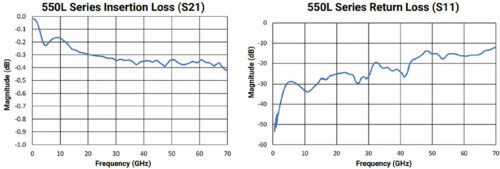A new single component coupling/DC blocking capacitor is now available.
Optoelectronics is becoming more of a commodity industry as the number of data centers continues to grow in support of cloud computing, 5G, and AI. When this is coupled with the way in which remote regions are becoming increasingly accessible and how social media is becoming increasingly pervasive to everyday life, it becomes clear that the performance and reliability of optical transmission networks will continue to grow in significance as well.
Typical ROSA (receiver optical sub-assembly) and TOSA (transmitter optical sub-assembly) circuits have DC blocking capacitors immediately after the photodiode. Also known as AC or RF coupling capacitors, the performance of these components across frequency are crucial to reducing signal processing errors, but achieving the desired performance can be difficult to implement because optical networks support very large bandwidths.
A common DC blocking (or coupling) implementation would be to have multiple capacitors of different values because there is a limited bandwidth at which they can provide this function, but one of the latest advancements in multi-layer ceramic capacitor (MLCC) technology includes a device with low-loss performance up to ~70GHz.
In addition to saving board space, having only one DC blocking capacitor also obviates the need for robust modeling of multiple blocking capacitors.
In the case of a 550L104K ultra-broadband EIA 0402 (0.04” x 0.02”) SMD capacitor from Kyocera-AVX Components, for example, the S21/S11 performance exhibits less than 0.4 dB of insertion loss up to about 67GHz. Smaller sizes exist, down to an EIA 01005, with a slight penalty to frequency performance but still well under 1dB of insertion loss up to the maximum frequency of 70GHz.
This high frequency performance is achieved by understanding and characterizing where parasitic capacitive/inductive losses are inherent in an MLCC. By employing equipment that can resolve unique electrode and termination geometries, these losses are minimized, and manufacturing tolerances are also minimized to improve lot-to-lot consistency.
By comparison, to remain cost competitive, standard MLCCs do not prioritize lot-to-lot consistency, nor are there design change notifications required. Standard MLCCs do suffice as coupling capacitors for many applications, but when it comes to high-speed digital or when frequencies of operation are above a gigahertz, care should be taken as to what level of signal integrity is acceptable.
Capacitor advancements typically fall under one or some combination of three main categories: support for high temperature, high voltage, or high frequency environments. The decades long trend of miniaturizing electronics has helped the case for MLCC high frequency capability because smaller case sizes naturally decrease the size of inductive loops.
However, the transition from metal to glass for the transmission of optical signals pushed the viable frequency spectrum beyond what the smallest standard MLCCs could support. Even terminating MLCCs on their side—so that their electrodes were perpendicular to the mounting surface—provided marginal increases in performance. Also, providing 2-capacitor modules as a “single component” solution were hard to process, model, and added to overall height.
For the optoelectronic and high reliability signal integrity markets, a new high frequency capacitor design was needed for a single component coupling/DC blocking capacitor, and this solution is now available.

